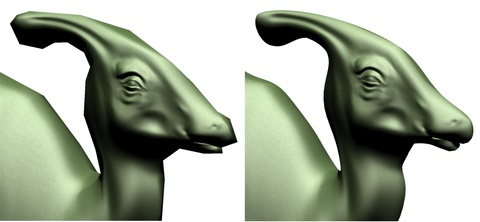Silhouette clipping

ACM SIGGRAPH 2000 Proceedings, 327-334.
Efficient computation of mesh silhouette, used to clip coarse geometry.
Abstract:
Approximating detailed models with coarse, texture-mapped meshes results in polygonal silhouettes. To
eliminate this artifact, we introduce silhouette clipping, a framework for efficiently clipping the
rendering of coarse geometry to the exact silhouette of the original model. The coarse mesh is obtained
using progressive hulls, a novel representation with the nesting property required for proper clipping. We
describe an improved technique for constructing texture and normal maps over this coarse mesh. Given a
perspective view, silhouettes are efficiently extracted from the original mesh using a precomputed search
tree. Within the tree, hierarchical culling is achieved using pairs of anchored cones. The extracted
silhouette edges are used to set the hardware stencil buffer and alpha buffer, which in turn clip and
antialias the rendered coarse geometry. Results demonstrate that silhouette clipping can produce
renderings of similar quality to high-resolution meshes in less rendering time.
Hindsights:
One fact that we forgot to mention in the paper is that backface/silhouette testing using a traditional
"sphere-cone test"
Abi-Ezzi and Subramaniam 1994
is equivalent to testing against some (non-optimized) anchored cone; by explicitly optimizing for
the position of the anchor as we do, one obtains a tighter culling test.
The progressive hull contribution hidden in this paper should find applications in collision detection.
Some recent techniques for accelerating ray tracing make use of our precomputed silhouette edge hierarchy. Shadow generation may be another application area.
See content copyrights.